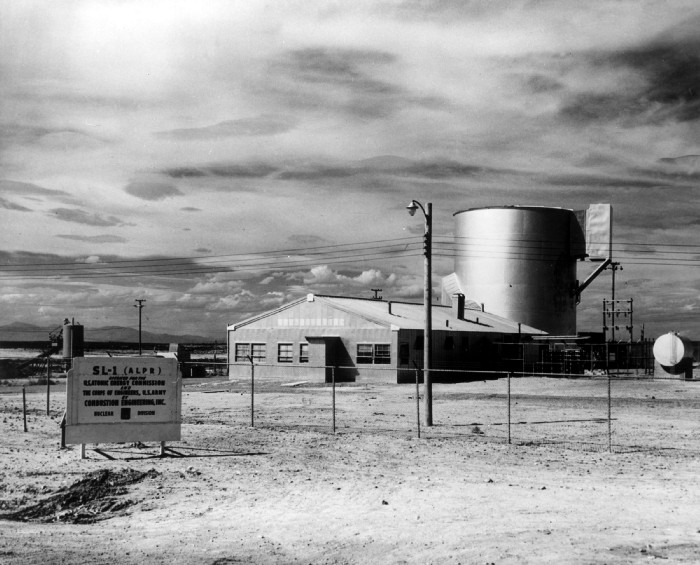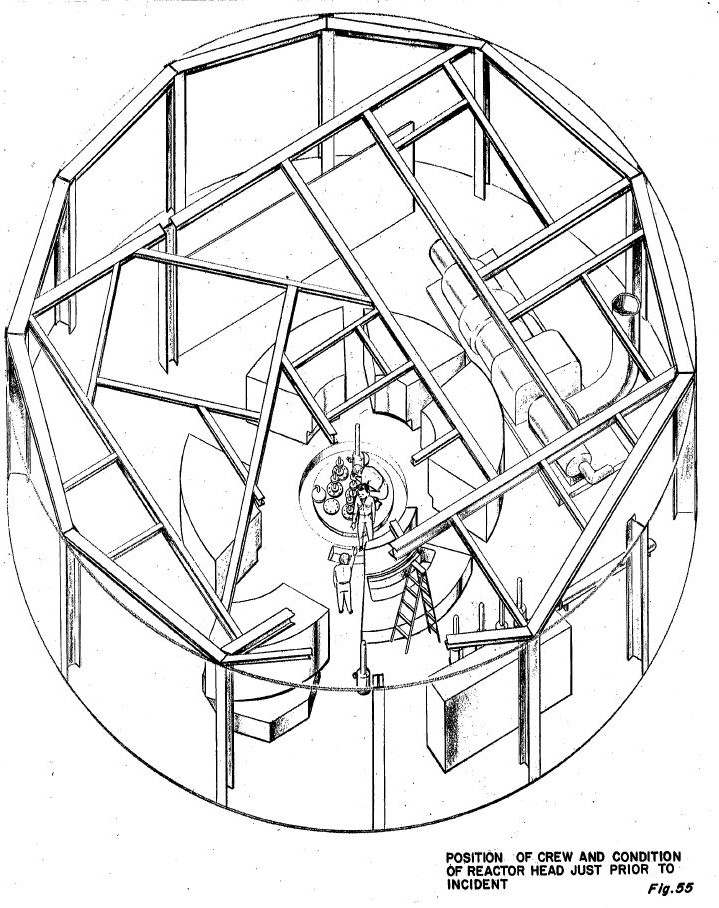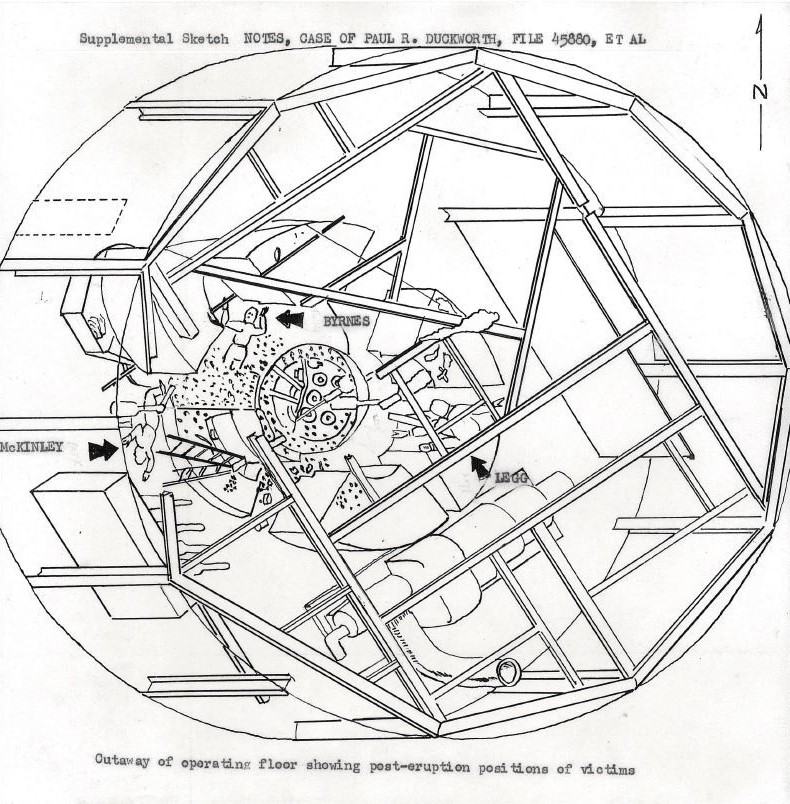
On Jan. 3, 1961, representatives of the Atomic Energy Commission and the Combustion Engineering Company were notified of an emergency at the National Reactor Testing Station located 8 miles north of Atomic City, Idaho.
The reactor building was a three-story cylindrical structure, 50 feet tall and 38 feet wide, constructed of sheet steel over steel framing over a concrete foundation.
A stairway, 4 feet wide and enclosed in sheet steel, followed the inside perimeter of the building as it ascended with a landing every 10 feet.
At the second-floor landing, a door opened outward to reveal the reactor’s operating room, which was 10 feet tall and 120 feet around. In the center of the crowded room was the reactor. Reaching 4 feet high, the reactor head was surrounded by a ring of shielding blocks. There was also a water control panel, an electric generator, a switch panel, and a feed panel in the room.
On the east side of the operating room, a door opened to a landing of another stairway curving downward along the building.
Richard L. McKinley, 33, health physicist supervisor, and John A. Byrnes III, 23, of the Army, together with Richard C. Legg, 27, a Navy man, were re-assembling the reactor after a minor change. They had moved some of the shielding blocks that surrounded the reactor head to better facilitate their work.
Inside the reactor room it was a scorching 90 degrees. The outside temperature was a frigid 1 degree.
At 10:35 p.m. a mistake caused uranium fuel in the reactor to change to a critical condition. Intense heat turned water in the system into steam, causing the top of the reactor to blow off.


Some of the fuel elements dislodged from the reactor head; steel pellets and other parts of the reactor, twisted metal, a step ladder, and dislodged piping was scattered about the room. The invisible threat of radioactive particles and heavy concentration of radioactive iodine filled the air.
McKinley and Byrnes were thrown to the floor. Byrnes lay with his legs covered by approximately four bushels of the steel pellets. Legg was blown to the ceiling, became caught on a dislodged brace, and was suspended there.
An automatic alarm system sounded, alerting firemen and guards, the only others then on duty in the immediate area.
Upon receiving notice, the representatives of the energy commission and the Combustion Engineering Company which had built the reactor were informed of the catastrophe.
They telephoned 37-year-old health physicist, Lovell J. Callister, who worked elsewhere on the station, and asked him to investigate while they drove to the scene.
Near the foot of the stairs leading to the reactor room, Callister performed tests which showed a high degree of radiation was present.
Upon identifying the gravity of the accident, Callister called Delos E. Richards, 35, a health physics technician, who had been working with him. Richards joined Callister at the scene and it was determined that McKinley, Byrnes, and Legg must still be inside.
By then, Combustion Engineering employees Edward J. Vallario, 33, health physicist supervisor; Paul R. Duckworth, 35, reactor operations supervisor; Sidney Cohen, 36, test supervisor; and William P. Rausch, 28, assistant operations supervisor, had arrived.
William P. Gammill, 32, health physicist with the energy commission, also arrived.
Tests taken at the foot of the stairs showed a radiation of more than 200 R, standing for roentgens per hour, the unit of measurement for radiation.
In their report, Hero Fund Investigators Irwin M. Urling and H.W. Eyman wrote about the testing station’s official and unofficial policy in regards to radiation exposure: workers’ radiation exposure was limited to 12 R in one year, which was considered safe. Off the record, entering radiation of more than 30 R was strictly on a voluntary basis, and no one was permitted to order anybody to enter so dangerous a field. An exposure of 100 R is considered permanently sterilizing and all exposure is cumulative.
Callister, Richards, Vallario, Duckworth, Cohen, Rausch, and Gammill discussed plans to rescue the three men from the reactor room. They agreed to participate, unanimously, although the conditions were dangerous and subject to change, triggering further radioactivity.
Hero hunters Urling and Eyman reported that all of the men were trained in atomic procedures and had training in rescue work.
With the exception of Callister and Richards, all of the other men had visited the operating room often, knew its arrangement, and were familiar with the three men trapped inside.
About 90 minutes after the explosion, Vallario and Duckworth, the highest ranking in their respective fields among the lot, decided to enter the room first.
It was mentioned by Vallario’s supervisors that in entering the room himself, Vallario acted entirely beyond his duties.
In their regular attire, the two men each put on a respirator mask, which had a glass front, permitting the view of only what lie ahead and inhibiting their hearing. Each mask had a hose connected to an air canister.
Vallario also took a radiation detector. He and Duckworth went to the stairway and ascended to the west door or the reactor room. As they got close, Vallario heard groans.
They entered the room to find debris scattered everywhere in the small space. The sudden change in temperature the freezing outside to 90 degrees inside, caused their masks to fog up.
Vallario and Duckworth noted McKinley on the floor and saw him move slightly before Vallario noticed Byrnes partially covered with steel pellets and blood.
After having been inside for a little over a minute, Duckworth and Vallario left the reactor room by the west door to get additional help.
They descended the stairs and each opened the glass front of his mask, taking a big breath of fresh air.
The other five men were joined by an Army captain and an Air Force sergeant and additional respirators and two stretchers had been acquired.
They relayed that McKinley was still alive, but they feared Byrnes was dead.
“The detector registered 500 R during the entire time we were in the room,” explained Vallario. He concluded that the radiation was as high as 1,000 R.
Cohen, Rausch, Gammill, Callister, and Richards put on respirators, and with Vallario and Duckworth leading, went to the bottom of the covered stairs.
“Wait,” Gammill paused, suggesting Callister and Richards wait outside since space was limited in the reactor room and because they might need someone to carry messages in case of an emergency.
The other five men ascended the stairs and entered the room.
Duckworth, Cohen, Vallario, and Gammill moved to McKinley, who still was moving slightly. Duckworth took hold of McKinley’s head and Gamill, his feet. Metal debris was caught in McKinley’s trousers and it took about 30 seconds to free him. Then Gammill walked backward, checking his path by looking over his shoulder, while they carried McKinley to the west door and placed him on a stretcher.
Rausch went to Byrnes and felt for a pulse. “Byrnes is dead,” he called, alerting the others. Meanwhile Gammill scanned the scene and Vallario moved aside debris, but neither man could find Legg. He and Rausch followed the others to the west door.
Suddenly, Duckworth’s respirator ran out of air, and he immediately exited through the west door. He had been inside about two minutes.
Two of the men took hold of the stretcher, and Vallario suggested they avoid the badly contaminated enclosed stairway and take McKinley down the open stairway instead.
Gammill said he would meet them there with a truck and left by way of the west door about 15 seconds after Duckworth had departed.
As the three men carried McKinley toward the east door, Vallario’s mask had been bumped and became inoperable.
Quickly opening the glass section, Vallario pleaded “Hurry, boys, I’m breathing it raw!”
They carried McKinley another 30 feet when they saw that the stretcher would not fit past the water control panel. With all three men walking backward and peering over their shoulders, they returned to the west door.
By now they had been in the room for about three minutes. Cohen, Duckworth, Gammill, Rausch, and Vallario descended the stairs and, with the aid of Callister and Richards, carried McKinley to a waiting ambulance.
Vallario and Rausch conveyed to the other men that Byrnes was dead. After stating they were unsure of Legg’s location and condition, Callister, Richards, the captain, and the sergeant, all wearing respirators, ascended the closed stairs to search for Legg.
The sergeant happened to look up and saw Legg suspended from the ceiling. He informed the other three men, and they concluded that Legg was dead.
The four men left the room after having been in it about one minute and provided the grim update.
At this point, rescue efforts were discontinued. The bodies of Byrnes and Legg would be removed from the room much later.
Meanwhile in the ambulance, McKinley’s respiration and pulse had ceased, and he could not be revived.
Although tests showed that radioactive particles of metal had been driven into McKinley’s body and he absorbed 400 R, his official cause of death was deemed concussion and wounds from the explosion.
Vallario, Duckworth, Rausch, Cohen, Gammill, Callister, Richards, and the two servicemen went to the decontamination building.
Vallario, had been in the reactor room for approximately four minutes on two trips. He was found to have absorbed about 25 R and, by breathing without the mask, he also absorbed harmful iodine from the air.
When reflecting on the risk he took, Vallario said he felt he was risking his life throughout the act because he might have absorbed a fatal amount of radiation, and because the situation was unprecedented and no one knew what to expect, especially since the fuel elements were scattered about and any impact with them might set off a fatal amount of radiation.
Callister and Richards lent their understanding of the danger they undertook to the tests Callister performed indicating high radiation levels. Both had been in the reactor room for approximately one minute and absorbed 11 R.
Duckworth and Cohen had been in the reactor room a total of about three minutes, each absorbing 27 R. Duckworth stated that he was conscious of the risk he undertook from the start and feared any misstep might have resulted in a second explosion. Cohen said his concerns focused on encountering a dislodged fuel element, which would have increased his exposure to radiation.
In attempting to determine if Byrnes was still alive, Rausch felt for a pulse and placed his hand between the man’s shoulder blades to see if there was respiration. Rausch knew this physical touch could result in him absorbing a lethal dose of radiation. He had absorbed 23 R in three minutes.
When prompted by Urling and Eyman, Gammill attributed his knowledge of the risk he undertook to the high radiation present and unknown conditions inside the radiation room. He had been inside for around two and a half minutes and absorbed 23 R.
Vallario, Callister Richards, Duckworth, and Gammill were forbidden to enter radioactive fields for at least six months.
All seven men were awarded the bronze Carnegie Medal and $500 for their actions.
—Abby Brady, Operations and Outreach assistant/Archivist

